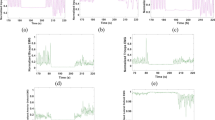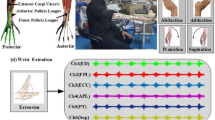Abstract
In the last decade, there has been huge advancement in biomechatronic systems by the integration of pattern recognition and regression algorithms. In many myoelectric control studies, high accuracy in estimating a subject’s wrist movement was reported by measuring electromyography (EMG) signal from subjects’ forearms. However, many algorithms suffer from limited robustness against undesired disturbance in the real-world environment. In particular, arm position change is an inevitable disturbance that results in severe degradation of performance. In this study, the weighted recursive Gaussian process (WRGP) is proposed to overcome this effect. In the algorithm, the noise variance is weighted by covariate shift adaptation, which is able to handle the uncertainties. WRGP is compared with the commonly used linear regression (LR) and multilayer perceptron (MLP). LR, MLP, and WRGP are trained with the EMG dataset acquired at an arm position and tested with the different EMG dataset acquired at another arm position. Also, WRGP with uniform weights and WRGP with the weights estimated from the covariate shift adaptation are compared. The results show that WRGP with uniform weights is more robust than LR and MLP regardless of the arm position (0.16 and 0.16 higher average \(R^2\) index, respectively). The performance of WRGP with the weights estimated from the covariate shift adaptation is significantly higher (\(p<0.05\)) than the performance of LR and MLP (0.30 and 0.33 higher average \(R^2\) index, respectively).









Similar content being viewed by others
Explore related subjects
Discover the latest articles, news and stories from top researchers in related subjects.References
Qi J, Jiang G, Li G, Sun Y, Tao B (2020) Surface EMG hand gesture recognition system based on PCA and GRNN. Neural Comput Appl 32(10):6343–6351. https://doi.org/10.1007/s00521-019-04142-8
Yang D, Gu Y, Thakor NV, Liu H (2019) Improving the functionality, robustness, and adaptability of myoelectric control for dexterous motion restoration. Exp Brain Res 237(2):291–311. https://doi.org/10.1007/s00221-018-5441-x
Farina D, Jiang N, Rehbaum H, Holobar A, Graimann B, Dietl H, Aszmann OC (2014) The extraction of neural information from the surface EMG for the control of upper-limb prostheses: emerging avenues and challenges. IEEE Trans Neural Syst Rehabil Eng 22(4):797–809. https://doi.org/10.1109/TNSRE.2014.2305111
Scheme E, Fougner A, Stavdahl Ø, Chan ADC, Englehart K (2010) Examining the adverse effects of limb position on pattern recognition based myoelectric control. In: 2010 annual international conference of the IEEE engineering in medicine and biology, pp 6337–6340
Geng Y, Zhou P, Li G (2012) Toward attenuating the impact of arm positions on electromyography pattern-recognition based motion classification in transradial amputees. J NeuroEng Rehabil 9(1):74. https://doi.org/10.1186/1743-0003-9-74
Liu J, Zhang D, Sheng X, Zhu X (2014) Quantification and solutions of arm movements effect on sEMG pattern recognition. Biomed Signal Process Control 13:189–197. https://doi.org/10.1016/j.bspc.2014.05.001
Jiang N, Muceli S, Graimann B, Farina D (2013) Effect of arm position on the prediction of kinematics from EMG in amputees. Med Biol Eng Comput 51(1):143–151. https://doi.org/10.1007/s11517-012-0979-4
Hwang HJ, Hahne JM, Müller KR (2017) Real-time robustness evaluation of regression based myoelectric control against arm position change and donning/doffing. PLoS ONE 12(11):e0186318. https://doi.org/10.1371/journal.pone.0186318
Hahne JM, Schweisfurth MA, Koppe M, Farina D (2018) Simultaneous control of multiple functions of bionic hand prostheses: performance and robustness in end users. Sci Robot 3(19):eaat3630. https://doi.org/10.1126/scirobotics.aat3630
Fougner A, Scheme E, Chan ADC, Englehart K, Stavdahl Ø (2011) Resolving the Limb position effect in myoelectric pattern recognition. IEEE Trans Neural Syst Rehabil Eng 19(6):644–651. https://doi.org/10.1109/TNSRE.2011.2163529
Yang D, Yang W, Huang Q, Liu H (2017) Classification of multiple finger motions during dynamic upper limb movements. IEEE J Biomed Health Inform 21(1):134–141. https://doi.org/10.1109/JBHI.2015.2490718
Park K, Suk H, Lee S (2016) Position-independent decoding of movement intention for proportional myoelectric interfaces. IEEE Trans Neural Syst Rehabil Eng 24(9):928–939
Vidovic MM, Paredes LP, Hwang H, Amsuss S, Pahl J, Hahne JM, Graimann B, Farina D, Müller K (2014) Covariate shift adaptation in EMG pattern recognition for prosthetic device control. In: 2014 36th annual international conference of the IEEE engineering in medicine and biology society, pp 4370–4373
Vidovic MM, Hwang H, Amsüss S, Hahne JM, Farina D, Müller K (2016) Improving the robustness of myoelectric pattern recognition for upper limb prostheses by covariate shift adaptation. IEEE Trans Neural Syst Rehabil Eng 24(9):961–970
Kanoga S, Kanemura A (2018) Assessing the effect of transfer learning on myoelectric control systems with three electrode positions. In: 2018 IEEE International Conference on Industrial Technology (ICIT), pp 1478–1483
Gretton A, Smola A, Huang J, Schmittfull M, Borgwardt K, Schölkopf B (2013) Covariate shift by kernel mean matching. In: Dataset shift in machine learning. https://doi.org/10.7551/mitpress/9780262170055.003.0008
Hahne JM, Dähne S, Hwang H, Müller K, Parra LC (2015) Concurrent adaptation of human and machine improves simultaneous and proportional myoelectric control. IEEE Trans Neural Syst Rehabil Eng 23(4):618–627. https://doi.org/10.1109/TNSRE.2015.2401134
Hahne JM, Markovic M, Farina D (2017) User adaptation in myoelectric man-machine interfaces. Sci Rep 7(1):4437. https://doi.org/10.1038/s41598-017-04255-x
Couraud M, Cattaert D, Paclet F, Oudeyer PY, de Rugy A (2018) Model and experiments to optimize co-adaptation in a simplified myoelectric control system. J Neural Eng 15(2):26006. https://doi.org/10.1088/1741-2552/aa87cf
Kapelner T, Vujaklija I, Jiang N, Negro F, Aszmann OC, Principe J, Farina D (2019) Predicting wrist kinematics from motor unit discharge timings for the control of active prostheses. J Neuroeng Rehabil 16(1):47. https://doi.org/10.1186/s12984-019-0516-x
Nielsen JLG, Holmgaard S, Jiang N, Englehart KB, Farina D, Parker PA (2011) Simultaneous and proportional force estimation for multifunction myoelectric prostheses using mirrored bilateral training. IEEE Trans Biomed Eng 58(3):681–688. https://doi.org/10.1109/TBME.2010.2068298
Muceli S, Farina D (2012) Simultaneous and proportional estimation of hand kinematics from EMG during mirrored movements at multiple degrees-of-freedom. IEEE Trans Neural Syst Rehabil Eng 20(3):371–378. https://doi.org/10.1109/TNSRE.2011.2178039
Jiang N, Vest-Nielsen JL, Muceli S, Farina D (2012) EMG-based simultaneous and proportional estimation of wrist/hand kinematics in uni-lateral trans-radial amputees. J Neuroeng Rehabil 9:42. https://doi.org/10.1186/1743-0003-9-42
Ameri A, Scheme EJ, Kamavuako EN, Englehart KB, Parker PA (2014) Real-time, simultaneous myoelectric control using force and position-based training paradigms. IEEE Trans Biomed Eng 61(2):279–287. https://doi.org/10.1109/TBME.2013.2281595
Rasmussen CE, Williams CKI (2018) Gaussian processes for machine learning. MIT Press, Cambridge. https://doi.org/10.7551/mitpress/3206.001.0001
Sheng H, Xiao J, Cheng Y, Ni Q, Wang S (2018) Short-term solar power forecasting based on weighted Gaussian process regression. IEEE Trans Ind Electron. https://doi.org/10.1109/TIE.2017.2714127
Feurer M, Letham B, Eytan Bakshy F (2018) Scalable meta-learning for bayesian optimization using ranking-weighted Gaussian process ensembles. In: AutoML workshop ICML 2018
Csató L, Opper M (2002) Sparse on-line Gaussian processes. Neural Comput. https://doi.org/10.1162/089976602317250933
Van Vaerenbergh S, Lazaro-Gredilla M, Santamaria I (2012) Kernel recursive least-squares tracker for time-varying regression. IEEE Trans Neural Netw Learn Syst 23(8):1313–1326. https://doi.org/10.1109/TNNLS.2012.2200500
Ameri A, Kamavuako EN, Scheme EJ, Englehart KB, Parker PA (2014) Support vector regression for improved real-time, simultaneous myoelectric control. IEEE Trans Neural Syst Rehabil Eng 22(6):1198–1209. https://doi.org/10.1109/TNSRE.2014.2323576
Hahne JM, Biessmann F, Jiang N, Rehbaum H, Farina D, Meinecke FC, Muller KR, Parra LC (2014) Linear and nonlinear regression techniques for simultaneous and proportional myoelectric control. IEEE Trans Neural Syst Rehabil Eng 22(2):269–279. https://doi.org/10.1109/TNSRE.2014.2305520
Gijsberts A, Bohra R, Sierra González D, Werner A, Nowak M, Caputo B, Roa MA, Castellini C (2014) Stable myoelectric control of a hand prosthesis using non-linear incremental learning. Front Neurorobot. https://doi.org/10.3389/fnbot.2014.00008
Krasoulis A, Vijayakumar S, Nazarpour K (2015) Evaluation of regression methods for the continuous decoding of finger movement from surface EMG and accelerometry. In: 2015 7th international IEEE/EMBS conference on neural engineering (NER), pp 631–634. https://doi.org/10.1109/NER.2015.7146702
Sayed AH (2003) Fundamentals of adaptive filtering. Wiley, New York
D’Avella A, Portone A, Fernandez L, Lacquaniti F (2006) Control of fast-reaching movements by muscle synergy combinations. J Neurosci. https://doi.org/10.1523/JNEUROSCI.0830-06.2006
Perez-Cruz F, Van Vaerenbergh S, Murillo-Fuentes JJ, Lazaro-Gredilla M, Santamaria I (2013) Gaussian processes for nonlinear signal processing: an overview of recent advances. https://doi.org/10.1109/MSP.2013.2250352
RojoÁlvarez JL, Martínez Ramón M, MuñozMarí J, CampsValls G (2018) Digital signal processing with kernel methods. Wiley, Chichester. https://doi.org/10.1002/9781118705810
Vegetabile BG, Gillen DL, Stern HS (2020) Optimally balanced Gaussian process propensity scores for estimating treatment effects. J R Stat Soc Ser A Stat Soc. https://doi.org/10.1111/rssa.12502
Kügelgen J, Mey A, Loog M (2020) Semi-generative modelling: covariate-shift adaptation with cause and effect features. In: AISTATS 2019—22nd international conference on artificial intelligence and statistics. arXiv:1807.07879
Jiang N, Rehbaum H, Vujaklija I, Graimann B, Farina D (2014) Intuitive, online, simultaneous, and proportional myoelectric control over two degrees-of-freedom in upper limb amputees. IEEE Trans Neural Syst Rehabil Eng. https://doi.org/10.1109/TNSRE.2013.2278411
Smith LH, Kuiken TA, Hargrove LJ (2016) Evaluation of linear regression simultaneous myoelectric control using intramuscular EMG. IEEE Trans Biomed Eng 63(4):737–746. https://doi.org/10.1109/TBME.2015.2469741
Li Y, Kambara H, Koike Y, Sugiyama M (2010) Application of covariate shift adaptation techniques in brain-computer interfaces. IEEE Trans Biomed Eng. https://doi.org/10.1109/TBME.2009.2039997
Spüler M, Rosenstiel W, Bogdan M (2012) Principal component based covariate shift adaption to reduce non-stationarity in a MEG-based brain-computer interface. Eurasip J Adv Signal Process. https://doi.org/10.1186/1687-6180-2012-129
Chowdhury A, Raza H, Meena YK, Dutta A, Prasad G (2018) Online covariate shift detection-based adaptive brain-computer interface to trigger hand exoskeleton feedback for neuro-rehabilitation. IEEE Trans Cognit Dev Syst. https://doi.org/10.1109/TCDS.2017.2787040
Raza H, Rathee D, Zhou SM, Cecotti H, Prasad G (2019) Covariate shift estimation based adaptive ensemble learning for handling non-stationarity in motor imagery related EEG-based brain-computer interface. Neurocomputing. https://doi.org/10.1016/j.neucom.2018.04.087
Yamada M, Sigal L, Raptis M (2014) Covariate shift adaptation for discriminative 3D pose estimation. IEEE Trans Pattern Anal Mach Intell. https://doi.org/10.1109/TPAMI.2013.123
Wichern G, Yamada M, Thornburg H, Sugiyama M, Spanias A (2010) Automatic audio tagging using covariate shift adaptation. In: ICASSP, IEEE international conference on acoustics, speech and signal processing—proceedings. https://doi.org/10.1109/ICASSP.2010.5495973
Author information
Authors and Affiliations
Corresponding author
Ethics declarations
Conflict of interest
The authors declare that they have no conflict of interest.
Additional information
Publisher's Note
Springer Nature remains neutral with regard to jurisdictional claims in published maps and institutional affiliations.
Rights and permissions
About this article
Cite this article
Jung, M.C., Chai, R., Zheng, J. et al. Enhanced myoelectric control against arm position change with weighted recursive Gaussian process. Neural Comput & Applic 34, 5015–5028 (2022). https://doi.org/10.1007/s00521-021-05743-y
Received:
Accepted:
Published:
Issue Date:
DOI: https://doi.org/10.1007/s00521-021-05743-y




